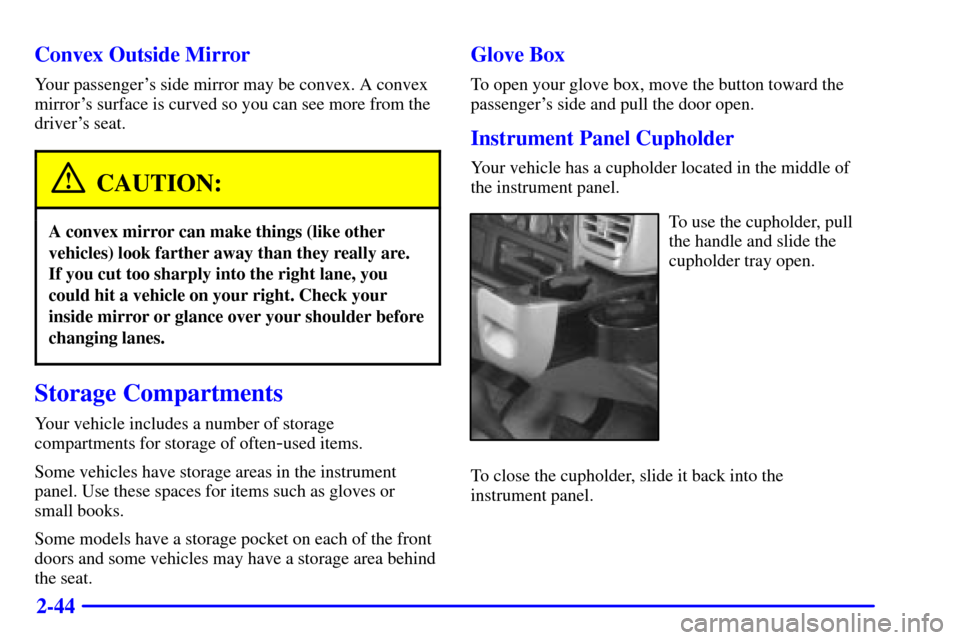Page 54 of 331

2-11 Key in the Ignition
If you leave your vehicle with the keys inside, it's an
easy target for joy riders or professional thieves
-- so
don't do it.
When you park your vehicle and open the driver's door,
you'll hear a tone reminding you to remove your key
from the ignition and take it with you. Always do this.
Your steering wheel will be locked, and so will your
ignition. If you have an automatic transmission, taking
your key out also locks your transmission. Also
remember to lock the doors.
Parking at Night
Park in a lighted spot, close all windows and lock your
vehicle. Remember to keep your valuables out of sight.
Put them in a storage area, or take them with you.
Parking Lots
Even if you park in a lot where someone will be
watching your vehicle, it's still best to lock it up and
take your keys. But what if you have to leave your
ignition key? What if you have to leave something
valuable in your vehicle?
�Put your valuables in a storage area, like your
glove box.�If your vehicle has a remote keyless entry system,
take the transmitter with you.
�Lock all the doors except the driver's.
Passlock�
Your vehicle is equipped with the Passlock
theft
-deterrent system.
Passlock is a passive theft
-deterrent system. Passlock
enables fuel if the ignition lock cylinder is turned with a
valid key. If a correct key is not used or the ignition lock
cylinder is tampered with, fuel is disabled.
During normal operation, the SECURITY light will
go off approximately five seconds after the key is
turned to RUN.
If the engine stalls and the SECURITY light flashes,
wait until the light stops flashing before trying to restart
the engine. Remember to release the key from START
as soon as the engine starts.
If the engine is running and the SECURITY light comes
on, you will be able to restart the engine if you turn the
engine off. However, your Passlock system is not
working properly and must be serviced by your dealer.
Your vehicle is not protected by Passlock at this time.
You may also want to check the fuses. See ªFuses
and Circuit Breakersº in the Index. See your dealer
for service.
Page 87 of 331

2-44 Convex Outside Mirror
Your passenger's side mirror may be convex. A convex
mirror's surface is curved so you can see more from the
driver's seat.
CAUTION:
A convex mirror can make things (like other
vehicles) look farther away than they really are.
If you cut too sharply into the right lane, you
could hit a vehicle on your right. Check your
inside mirror or glance over your shoulder before
changing lanes.
Storage Compartments
Your vehicle includes a number of storage
compartments for storage of often
-used items.
Some vehicles have storage areas in the instrument
panel. Use these spaces for items such as gloves or
small books.
Some models have a storage pocket on each of the front
doors and some vehicles may have a storage area behind
the seat.
Glove Box
To open your glove box, move the button toward the
passenger's side and pull the door open.
Instrument Panel Cupholder
Your vehicle has a cupholder located in the middle of
the instrument panel.
To use the cupholder, pull
the handle and slide the
cupholder tray open.
To close the cupholder, slide it back into the
instrument panel.
Page 92 of 331
2-49
The main components of your instrument panel are the following:
A. Dome Override Button
B. Exterior Lamps Control
C. Air Outlets
D. Multifunction Lever
E. Instrument Panel Cluster
F. Gearshift Lever
G. Audio System
H. Comfort Control System
I. Glove BoxJ. Fuse Block
K. Hood Release
L. Parking Brake Release
M. Tilt Lever (If Equipped)
N. Storage Area (If Equipped)
O. Accessory Power Outlets
P. Cupholder
Q. Ashtray
Page 254 of 331
6-59
Vehicle Identification Number (VIN)
This is the legal identifier for your vehicle. It appears
on a plate in the front corner of the instrument panel,
on the driver's side. You can see it if you look through
the windshield from outside your vehicle. The VIN also
appears on the Vehicle Certification and Service Parts
labels and the certificates of title and registration.
Engine Identification
The 8th character in your VIN is the engine code.
This code will help you identify your engine,
specifications and replacement parts.
Service Parts Identification Label
You'll find this label on the inside of the glove box.
It's very helpful if you ever need to order parts.
On this label is:
�your VIN,
�the model designation,
�paint information and
�a list of all production options and
special equipment.
Be sure that this label is not removed from the vehicle.
Page 257 of 331
6-62
Fuse/Circuit
BreakerUsage
1 Stop/TCC Switch, Buzzer,
Center High Mounted Stop Lamp,
Hazard Lamps, Stoplamps
2 Not Used
3 Courtesy Lamps, Cargo Lamp,
Glove Box Lamp, Dome/Reading
Lamps, Vanity Mirrors
4 Instrument Cluster, DRL Relay,
Lamp Switch, Keyless Entry,
Low Coolant Module,
Illuminated Entry Module,
DRAC (Diesel Engine)
5 Not Used
6 Cruise Control
7 Auxiliary Power Outlet
8 Crank